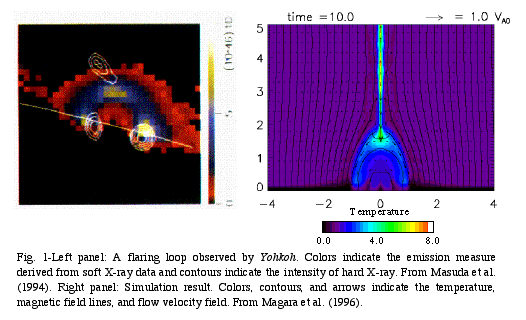
This work is based on one of the new observational findings by Yohkoh, which is a hard X-ray loop-top source formed over a soft X-ray flaring loop in a compact (impulsive) flare (Masuda et al. 1994; left panel in Figure 1). In order to clarify the generation mechanism of this loop-top source, we performed two-dimensional MHD simulations for reproducing relevant dynamic processes suggested by the so-called CSHKP model, a famous solar flare model based on magnetic reconnection. We found that a plasma jet originating from a reconnection point collided with an underlying closed loop to produce a standing fast-mode MHD shock wave, behind which a hot and dense source was generated and maintained (Magara et al. 1996; right panel in Figure 1). We confirmed that the temperature of this source is consistent with that derived from the hard X-ray data (about hundred million degrees) when thermal radiation is assumed and a realistic value of plasma β is used (β = 0.01) (Magara 1998). On the basis of these results, we discussed that difference in appearance between short-lived compact flares (impulsive flares) and long-duration-event flares (LDE flares) may depend on efficiency of the magnetic reconnection operating above the soft X-ray flaring loop (Magara et al. 1996).
Magara, T., Mineshige, S., Yokoyama, T., & Shibata, K. 1996, ApJ, 466, 1054
Magara, T. 1998, Ph. D. Thesis, Univ. Kyoto
Masuda, S., Kosugi, T., Hara, H., Tsuneta, S., & Ogawara, Y. 1994, Nature, 371, 495
